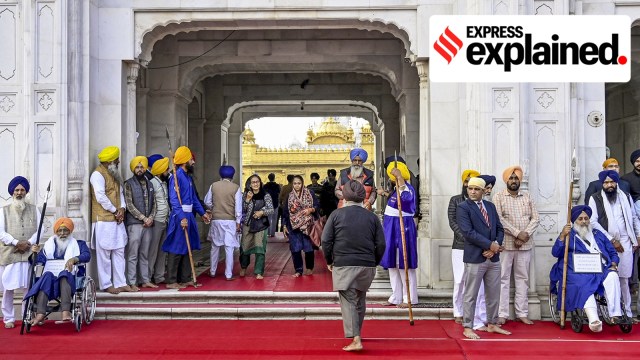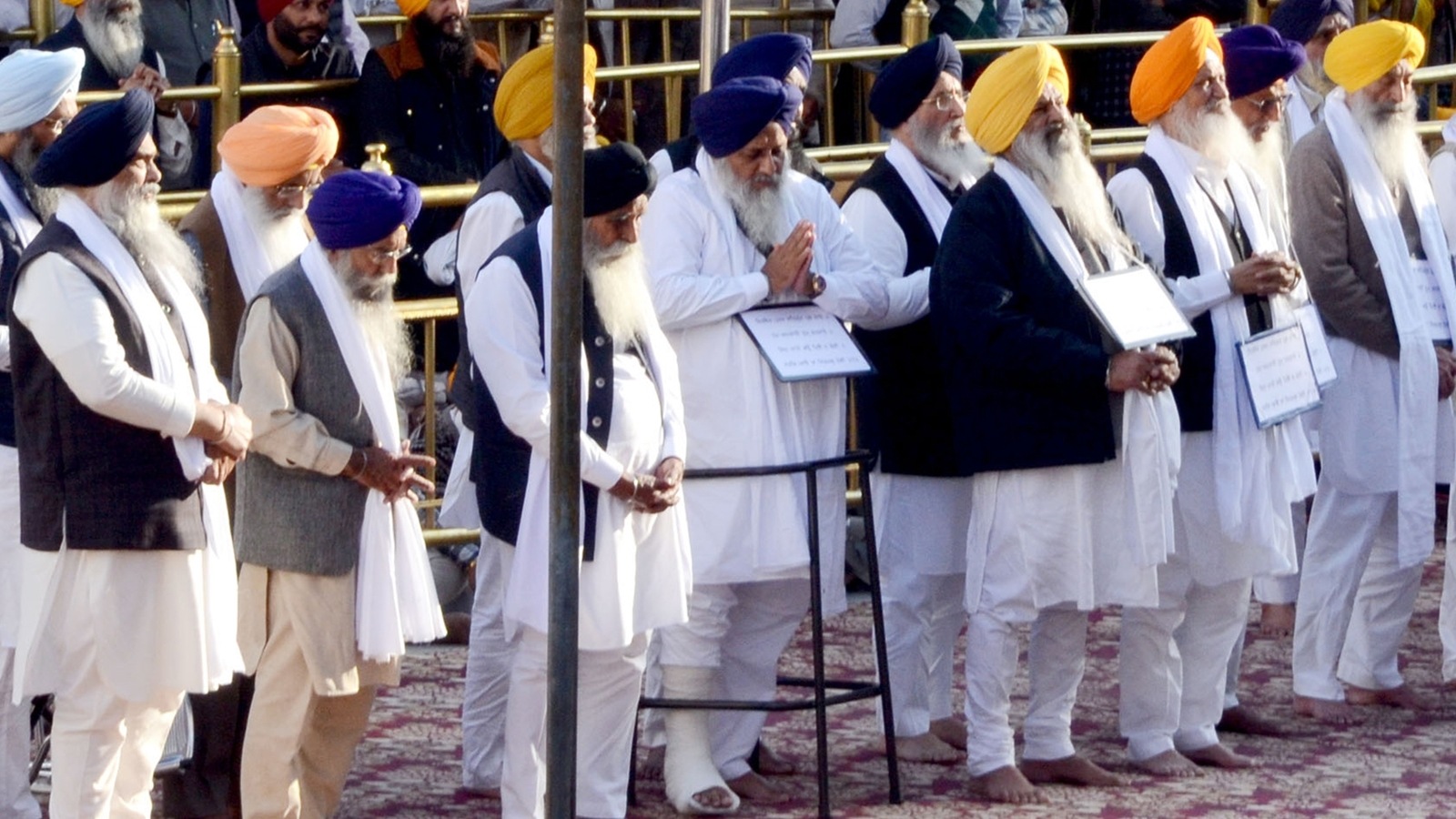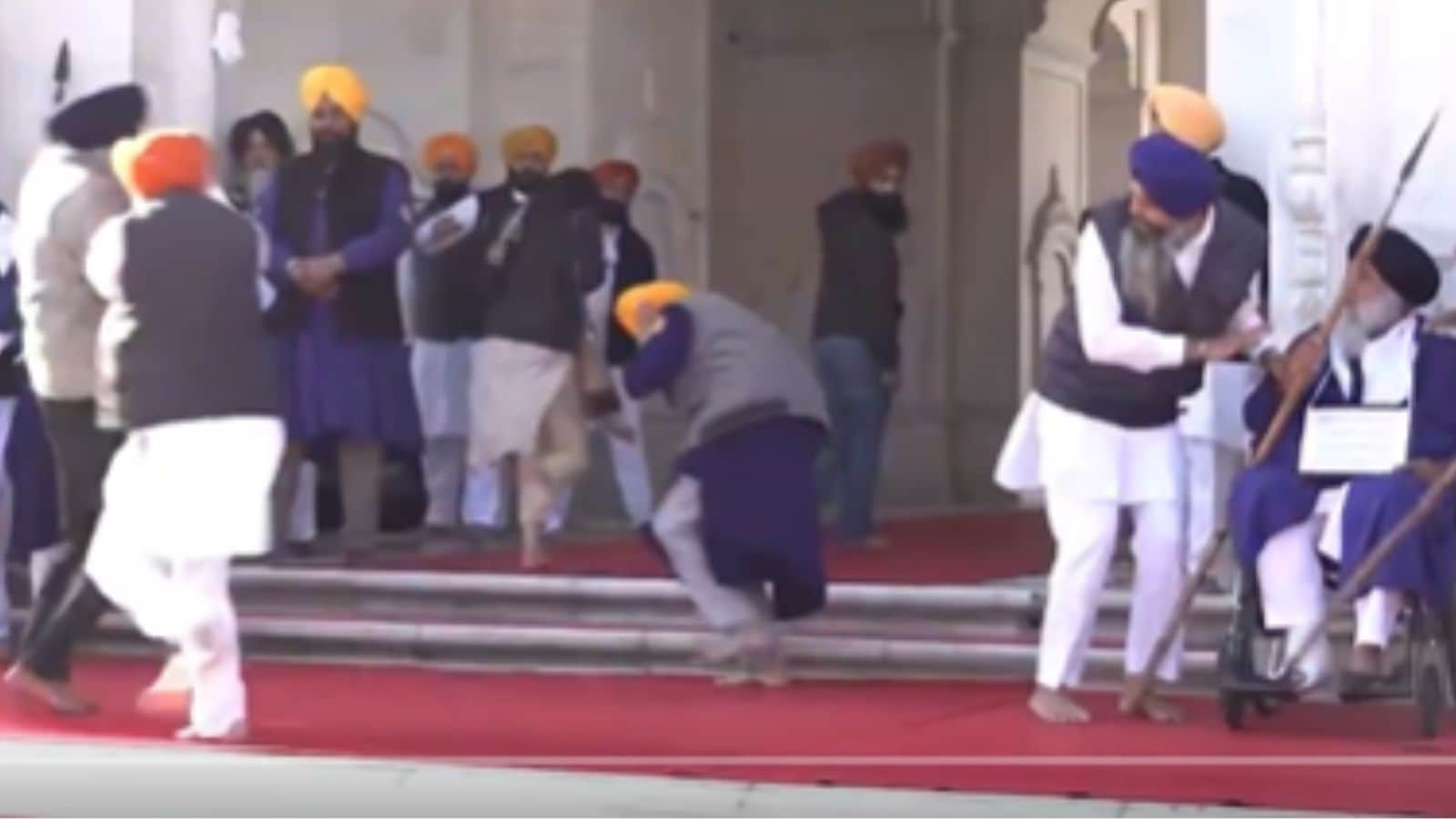Explained: Akal Takht, SAD, and the punishment to Sukhbir Singh Badal
Akal Takht has imposed religious punishment on Sukhbir Singh Badal. What is the relationship between the supreme temporal and spiritual seat of Sikhs and the Shiromani Akali Dal, which Badal heads?
 Shiromani Akali Dal President Sukhbir Singh Badal (on a wheelchair on extreme right) at the entrance to the Golden Temple to serve religious punishment on Tuesday. (PTI)
Shiromani Akali Dal President Sukhbir Singh Badal (on a wheelchair on extreme right) at the entrance to the Golden Temple to serve religious punishment on Tuesday. (PTI)President of the Shiromani Akali Dal (SAD) Sukhbir Singh Badal was shot at on Wednesday (December 4) at the entrance to the Golden Temple where he was on guard duty.
Badal, who was on a wheelchair with his fractured right foot in a cast when the attacker approached him, was not hurt.
The former Deputy Chief Minister of Punjab has been awarded religious punishment by the Akal Takht, the supreme temporal seat of the Sikhs, for the alleged misrule of the SAD government from 2007 to 2017.
Other members of the then Cabinet are also performing atonement on the order of the Akal Takht by cleaning bathrooms and utensils, etc.
What is the Akal Takht, what position does it occupy in the Sikh community, and what is the source of the authority it wields over the Akali Dal?
When and why was the Akal Takht established?
The Akal Takht, which faces the Harmandir Sahib in the Golden Temple complex, was established by the sixth Sikh master Guru Hargobind in 1606 following the execution of his father, Guru Arjan Dev, by the Mughals.
 Sukhbir Singh Badal with others. (Express photo by Rana Simranjit Singh)
Sukhbir Singh Badal with others. (Express photo by Rana Simranjit Singh)
According to Sikh Studies scholar Amarjit Singh of Guru Nanak Dev University, Amritsar, Guru Hargobind used this platform for governance, and is believed to have issued the first directive (Hukamnama) from here, urging Sikh congregations to contribute horses and weapons to the Panth.
The Guru is said to have requested two swords, symbolising miri (temporal power) and piri (spirituality). The sword representing miri was slightly shorter, indicating the primacy of spiritual authority over temporal power.
The Akal Takht was also a symbol and representation of the Sikh defiance of Mughal authority. Historian Joginder Singh, a former professor at Guru Nanak Dev University, who has written extensively on Sikh history, noted that the 12-foot-high platform of the Akal Takht symbolised a challenge to the Mughal government in Agra (and later Delhi), where Emperor Jahangir (1605-27), on whose order Guru Arjan Dev was executed, sat on an 11-foot-high throne, and forbade anyone else from doing so.
How did the Akal Takht function after the passing of the tenth and last Guru, Guru Gobind Singh?
The Akal Takht became the focal point for Sikhs during the difficult period following the execution of Banda Singh Bahadur, the general of the Khalsa army, in 1716, Prof Amarjit Singh said.
As the Sikhs faced massive persecution from the Mughal state, members of the community would gather at the Akal Takht on Baisakhi and Diwali for Sarbat Khalsa assemblies where crucial decisions would be made.
The tradition of the Sarbat Khalsa continued, and one of the last assemblies was convened by Maharaja Ranjit Singh (1801-39), the founder of the Sikh empire, in 1805 to deliberate on supporting the Maratha prince of Indore, Jaswant Rao Holkar, against the British.
 Shiromani Akali Dal leader Sukhbir Singh Badal at the Golden Temple to serve the ‘tankhah’ (religious punishment) given to him by the Akal Takht, in Amritsar. (PTI photo)
Shiromani Akali Dal leader Sukhbir Singh Badal at the Golden Temple to serve the ‘tankhah’ (religious punishment) given to him by the Akal Takht, in Amritsar. (PTI photo)
How is the Jathedar (head) of the Akal Takht appointed?
Initially, the Sarbat Khalsa appointed the Akal Takht Jathedar during the annual congregations. After the British established control over the country, however, the appointment of the Jathedar came under the influence of the Darbar Sahib committee, which was dominated by leaders who were loyal to the regime.
Following the enactment of the Sikh Gurdwaras Act in 1925, the Jathedar began to be appointed by the Shiromani Gurdwara Parbandhak Committee (SGPC), a body formed in 1920 to manage Sikh shrines and free them from British-supported mahants.
The SGPC is currently the apex governing body of all Sikh gurdwaras in the states of Punjab and Himachal Pradesh, and the Union Territory of Chandigarh.
How does the Akal Takht hand out religious punishment?
As the head of the highest seat of temporal power of the Sikhs, the Jathedar of the Akal Takht is the supreme temporal and religious authority of the Sikhs, and the final word on the affairs of the community.
The Jathedar must be baptised, possess deep knowledge of Sikh history and scriptures, and should be free from moral shortcomings.
Any person who identifies as a Sikh can be summoned to the Akal Takht, tried, and sentenced. Dr Sarabjinder Singh, Dean, Guru Nanak Dev University and Jagat Guru Nanak Dev Punjab State Open University, said that the Akal Takht’s justice applies only to those who voluntarily submit to its authority.
 Sukhbir Singh Badal and former Rajya Sabha MP Sukhdev Singh Dhindsa were made to stand guard. (Express photo)
Sukhbir Singh Badal and former Rajya Sabha MP Sukhdev Singh Dhindsa were made to stand guard. (Express photo)
“The Takht calls only those who affirm their Sikh identity, and tankhah (religious punishment) is intended to remove ego and instill humility. No one has ever repudiated the Takht’s directives,” he said.
Among the prominent Jathedars of the Akal Takht was Akali Phoola Singh, who summoned Maharaja Ranjit Singh for a moral transgression, resulting in the Maharaja receiving punishment of a public flogging at the Akal Takht.
What is the relationship between the Shiromani Akali Dal (which Sukhbir Singh Badal leads), and the SGPC (which appoints the Akal Takht Jathedar)?
The SGPC and SAD share a historically intertwined relationship rooted in the Gurdwara Reform Movement of 1920.
The SGPC was established on November 15, 1920 to manage historical Sikh shrines, while the SAD, formed on December 14 that same year, initially acted as a task force of the SGPC to mobilise Sikhs against corrupt mahants and British interference in gurdwaras.
Both organisations institutionalised the Khalsa identity as central to Sikhism, and became pillars of the Sikh religious and political leadership.
Ashutosh Kumar, a professor of political science at Panjab University, Chandigarh, described the Akal Takht, SGPC, and the Shiromani Akali Dal as the “three poles” of Sikh politics.
 Screengrab of moment when shots were fired at SAD leader Sukhbir Badal outside the Golden Temple on Wednesday.
Screengrab of moment when shots were fired at SAD leader Sukhbir Badal outside the Golden Temple on Wednesday.
The SAD has often sought to control the SGPC through electoral dominance. The SGPC’s general house, with 191 members, includes 170 elected members. Controlling the SGPC, which appoints the Akal Takht Jathedar, gives SAD significant influence.
The Akalis dominated the SGPC in the 1960s and 1970s — and even in 1979, when the turmoil in Punjab had begun, they won the majority of seats in the SGPC. Akali control over the SGPC began to slip gradually after Gurcharan Singh Tohra was installed as the SGPC president in 1973, a post that he held for 27 years.
After Tohra’s demise and the decline of militancy, the Akalis regained control of the SGPC. Elections to the body are supposed to be held every five years, but no elections have been held since 2011. Some critics say the SAD continues to be influential in the SGPC house primarily for this reason.
Some observers have suggested that the relationship between the SGPC and SAD is akin to the one that exists between the RSS and BJP. However, Dr Pramod Kumar, chairperson of the nonprofit research organisation Institute for Development and Communication (IDC), Chandigarh, said this is not an apt comparison.
“The RSS identifies itself as a social and cultural organisation that is more about [nationalist] ideology, while the SGPC is a religious and social organisation concerned with the management of Sikh shrines and charitable schools and hospitals,” he said.
How has SAD control over the SGPC impacted its relationship with the Akal Takht Jathedar?
On several occasions, the Akal Takht Jathedar’s decisions have appeared to be influenced by the SAD.
* During the 1990s, when Parkash Singh Badal led the SAD and Gurcharan Singh Tohra presided over the SGPC, concerns were expressed over the fairness and credibility of Jathedars.
* In 1994, the acting Akal Takht Jathedar, Prof Manjit Singh, tried to unite fractured Akali factions, but Badal’s faction resisted. Badal was summoned to the Akal Takht, leading to public confrontations at the Darbar Sahib complex.
* During the Tohra-Badal feud in 1999, the Badal camp pushed for the removal of Akal Takht Jathedar Bhai Ranjit Singh, which happened on February 10, 1999.
* After 2005, when the SAD leadership began deciding the SGPC president, the concerns about political interference intensified. Avtar Singh Makkar, a relatively unknown figure in Akali politics, became SGPC president, and held the post for 11 years.
* Akal Takht Jathedar Gurbachan Singh, along with other high priests, faced a backlash for announcing a controversial unilateral pardon to Gurmeet Ram Rahim Singh, the Sirsa dera chief, in September 2015, which was later revoked. Many Sikhs had alleged that the decision was influenced by the SAD — which was confirmed by Sukhbir Singh Badal during his questioning by the Akal Takht Jathedar on December 2.
- 01
- 02
- 03
- 04
- 05






































